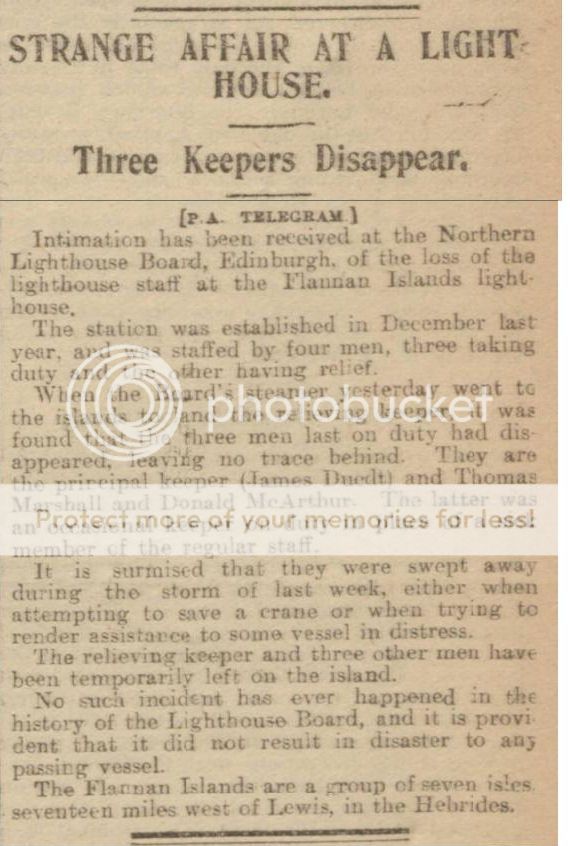-
*Astrella.
User deleted
The Flannan Isles Lighthouse Mystery

In December 1900 three lighthouse-keepers, Thomas Marshall, James Ducat and Donald McArthur, on the lonely outcrop of the Flannan Isles, approx 20 miles from the Outer Hebrides, western Scotland, disappeared without trace. No solution to their disappearance has ever been found, and for over a 100 years now this case has been of endless fascination to those of us who love unsolved mysteries.
The riddle of the Flannan Isles has inspired stories, poems, songs, even an opera. Endless speculations about their fate have been imaginative in the extreme. Something about the mystery of these 3 men, isolated at the edge of the world, surrounded by the hostile Atlantic Ocean, gets under our skin.
The Flannan Isles (also known as the Seven Hunters) are named after a 7th century Irish priest called St Flannan. Apart from the 70 years when the lighthouse was manned, the windswept islands have always largely been uninhabited. The only other structure on the islands, apart from the lighthouse, is a tiny ruined chapel, dedicated to St Flannan.
The islands were always viewed with great superstition by the Hebrideans, and although they used the islands to graze sheep, believed it was unlucky to spend a night there. They observed such practices as removing your hat and upper clothing, and turning in a sunwise direction, when arriving there.
The lighthouse was constructed in the 1890s on the island known as Eilean Mor (Big Isle). It took 4 years, and building work was continually hampered by the difficulties of safely landing supplies on the island, and the tempestuousness of the wild Atlantic Ocean.
The lighthouse first went into operation on 7 December 1899. It had no wireless communication, and its only communication with the outside world was a series of semaphore-style balls on posts, which could be seen by the Hebrides on a good day.
The mystery begins on the night of 15 December 1900, when a squall broke out in the vicinity of the islands. The crew of a passing ship, the Fairwind, were angry and disturbed that no guiding light from the newly-built Flannan Isles lighthouse appeared to be in operation. Likewise the steamer Archtor (or Archer as I’ve also seen it recorded), when it docked at Oban, reported that the light was not operating.
Nothing appears to have been done about it. Perhaps the authorities felt that it was best to wait a few days, as the relief ship, the Hesperus, was due to sail out to the islands on the 20th December.
Bad weather delayed the sailing though, and the Hesperus didn’t set out until dawn on Boxing Day, carrying fresh supplies for the lighthouse, and Joseph Moore, who was due to relieve one of the other keepers on watch duty. Moore was anxious about the mystery of the dead light. He knew that it was virtually unheard of for lighthouse-keepers to allow a light to go out like that. It was said that during the short voyage to the islands he was restless, filled with foreboding, pacing the deck and refusing any breakfast.
Things were eerie on the lighthouse island from the moment they arrived. There was no welcoming committee from the three men, (who would normally have been outside to greet them), no provisions boxes had been put out to be re-stocked, and the flag wasn’t up on the flagstaff. The Hesperus moored in silence, and Joseph Moore headed for the lighthouse, calling out as he headed towards it.
Inside the lighthouse nothing looked out of order. The lamps were trimmed, the beds were tumbled, as if they men had just got up, the washing-up done, cold ashes in the grate. Other reports have it that a chair was overturned in the kitchen, (although some observers believe this was a later, journalistic, embellishment), and the clocks had all stopped.
What is agreed is that two sets of outdoor gear were missing, and only one set of oilskins remained. Which meant one of the men had gone out without his protective weather gear on. Something that would have been virtually unheard of. Not only was this wholly impractical, but for all 3 men to leave the light unattended at once went against the rules laid down by the Northern Lighthouse Board. The only set of outdoor clothing which remained belonged to Donald McArthur.
So much myth and folklore has grown up over the Flannan Isles mystery, that some have reported that when Joseph Moore first opened the main door, three strange birds flew out, and, as the lighthouse tower was searched,odd strands of seaweed were found on the stairs, and in the little cubby-hole where the lighthouse logbook was kept.
A comprehensive search was also made of the island itself. At the west landing stage they found extraordinary damage. Iron railings were bent out of shape, and the iron railway by the path was completely wrenched out of the concrete. The conclusion was that the damage had been caused during a terrible storm.
Captain Garvie sent a telegram to the Northern Lighthouse Board, saying that “a dreadful accident” had happened at Flannan. He concluded the “poor fellows must have blown over the cliffs or drowned trying to rescue a crane or something like that”.
When the logbook was perused, it made for disturbing reading. Keeper Thomas Marshall recorded as follows:
“December 12. Gale north by northwest. Sea lashed to fury. Never seen such a storm. Waves very high. Tearing at lighthouse. Everything shipshape. James Ducat irritable”.
Later that day: “Storm still raging, wind steady. Stormbound. Cannot go out. Ship passing sounding foghorn. Could see lights of cabins. Ducat quiet. Donald McArthur crying”.
“December 13. Storm continued through night. Wind shifted west by north. Ducat quiet. McArthur praying”. Later: “Noon, grey daylight. Me, Ducat and McArthur prayed”.
On 14 December there was no entry in the log.
The final entry was made on a slate, which (under normal circumstances) would have been transferred to the logbook proper later on:
“December 15. 1pm. Storm ended, sea calm. God is over all”.
It was on the evening of the 15th that it was observed that the light hadn’t been lit. So the men must have disappeared sometime in the few hours between the last log entry and night-fall, which at that time of year, and in that area would have occurred at around 4 PM.
There is much controversy over the log entries. Most particularly, the highly emotive quality of the entries. This was an official log-book, the entries would ordinarily have been the bare bones of the daily running of the light. It wasn’t a private diary, there for the men to record their feelings. Take the entry where Marshall records “James Ducat irritable”. It has been pointed out that Ducat was Marshall’s superior.
This would be akin to someone writing on the office messageboard that the boss was in a bad mood. If the men had lived, The Northern Lighthouse Board would have asked Marshall to explain why he had made such a personal entry. Also Ducat was reputed to have normally been a very good-natured man. Such irritability would have been out-of-character (although I have to say that even the most good-natured of men might have suffered irritability in those trying circumstances).
The “McArthur crying” entry is also extraordinary. It makes McArthur sound like a snivelling boy, when by all accounts he was a tough old sea-dog, of many years experience. On the mainland he was known as a bit of a brawler. He must have endured his fair share of violent storms over the years, so why did this one reduce him to a pulp?
The final entry also aroused some surprise. Superintendent Muirhead, who was part of the official investigation into the disapperances, knew all the men personally, and said he had never thought of any of them as particularly God-fearing, or prone to prayer.
Writer Mike Dash has suggested that the logbook entries may in fact have been a hoax, that they were written afte the 15th December. It’s unlikely we’ll ever know the truth to that, but if the entries were faked, then WHY?? After I first blogged about this case, I was contacted by Mike Dash, who said that the log-book entries had been invented by an American pulp fiction magazine, who had invented that angle to jazz the story up for their readers. Some things never change I guess.
The Northern Lighthouse Board carried out an official investigation into the disappearances, and concluded that it was most likely that the men had been swept away by a freak wave as they were trying to secure things on the west landing area. That two of the men had got into trouble, and that McArthur had dashed outside in his shirt-sleeves to help them.
There have of course been much more dramatic explanations for the mystery, such as sea monsters and aliens. It has even been speculated that a long-boat full of ghosts were seen heading to the islands on the night the light went dark. Some have said that the long-boat full of ghosts may in fact have been the three lighthouse-keepers rowing furiously away.
I’ll close with the words of Superintendent Muirhead, who, in his official report of 8 January 1901, said “I visited them as lately as 7th December and have the melancholy recollection that I was the last person to shake hands with them and bid them adieu”.
Source: http://sjhstrangetales.wordpress.com/2012/...thouse-mystery/.
The Flannan Isles Lighthouse Mystery28 Maggio 2013 |


